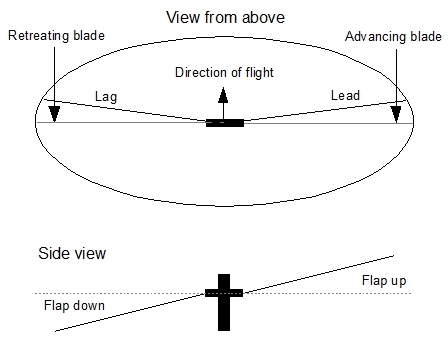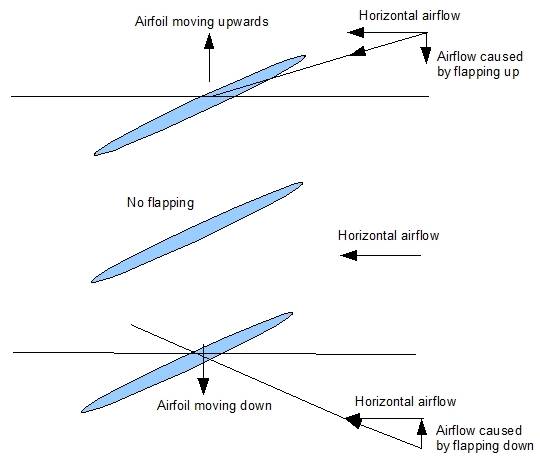Rotordisc and Forward Flight
When in forward flight, there is an important difference to the circumstances of a helicopter in a hover, namely its airspeed due to its forward movement. We
will now look at the effects of
this additional airspeed on the rotors in the rotordisc. To assist us in discussing
this subject, we will make the following assumptions: the rotors are rotating anti-clockwise,
seen from above; and the extra airspeed is generated solely because of the forward
speed of the helicopter. We will discriminate between the advancing and the retreating
blade, the former being the blade that moves in the same direction
as the helicopter,
whereas the latter moves in the opposite direction. Note that in one complete
revolution, each blade will play both the advancing and the retreating roles (both
roles for half a revolution).

The effect of forward speed on the rotors is easily explained. Firstly, think about
the rotordisc when the helicopter is in a hover (no forward speed). In this scenario,
each rotor-blade encounters the same airspeed, which is defined by the speed of
rotation of the rotorsystem. As a result, all of the blades in the rotordisc contribute
the same amount of lift. Note that we can't speak of an advancing or a retreating
blade in these circumstances.
So, let’s take forward speed into account. The advancing blade now encounters a higher
relative airspeed because, as a result of rotation, the forward speed must be added to the airspeed. Using the same line of reasoning, the retreating blade will encounter a lower relative
airspeed. Because the lift of a blade depends on the squared relative airspeed,
the advancing blade will produce substantially more lift than the retreating one.
The result is a rotordisc which suffers from asymmetrical lift distribution over
the disc.
Asymmetrical lift distribution along the rotordisc
is one reason why the blades must be able to flap up and down. This can be realized either by hinges
in the rotorhead, or by designing rotorblades which are flexible at the root.
Flap Back
We can now look again at the helicopter in forward flight, but this time taking
into account that the lift distribution is asymmetrical, while the
blades can also
flap. So, what will happen? The advancing blade will flap up and the retreating
one down. This has the effect that the rotordisc orientates itself backwards, slowing the helicopter down. This is known as 'flap back', and must be compensated for
by applying (forward) cyclic. This example highlights that the effects of asymmetrical
lift production are not merely compensated for by blade flapping, but also by applying corrective cyclic input (pilot action). You should be aware that there are a lot of textbooks which don't mention this (correctly).
When the advancing blade flaps up, its angle of attack decreases, which reduces its
lift considerably. When the blade flaps down, however, the angle of attack increases,
which produces more lift. When the blades have enough freedom to flap up and down,
this mechanism will then balance itself out automatically: blade
flapping is dampened
down by aerodynamic forces.
To understand why the angle of attack changes when a
blade flaps up or down, one has to realize that the up and down flapping involves a vertical
movement of the blade, which influences the relative airflow (RAF). Imagine the
hypothetical situation in which there is no horizontal airflow (which, of course,
is not possible with the blades rotating). In this situation, there would only be
vertical airflow due to the blade flapping. When the blade flaps up, the relative
airflow would come from above, and the angle of attack would equal -90 degrees. Now, we must make the situation realistic by adding the vertical airspeed to the horizontal airflow component that
we first left out. Now, the relative airflow has a smaller angle of attack
when compared
to the situation where there is no
upward blade movement (no flapping). This explains the
smaller angle of attack. When the
blade flaps down, the same mechanism increases the angle of attack (by introducing
a vertical airspeed component that goes up instead of down).

When the blades flap up and down, a Coriolis force will work on them.
When a blade flaps up, this
Coriolis force will act in a forwards direction, accelerating the blade forwards.
The blade will lead ('move ahead'). When the blade flaps back again, the opposite
occurs and the blade will lag ('stay behind'). This explanation, which is based
on Coriolis, is only valid in a rotating reference frame; that is, the reference
frame rotates with the same angular velocity as the rotor blade.
When we assume a non-rotating reference frame (inertial reference frame), the lead
and lag movements are explained by the law of conservation of angular momentum.
When a blade flaps up, its centre of mass moves towards the shaft. In order to conserve
angular momentum, the speed of the blade has to increase. When the blade flaps down,
the opposite happens and the blade slows down. Both explanations are equally valid.
This lead and lagging is an important reason
why rotorheads and/or rotorblades are designed to allow for the rotational freedom of the blades in the plane of rotation
around the shaft. Another reason is
the Hookes’ joint effect.
Next topic > Harmonic Blade Motion and Vibration
|
Helicopter Theory (Paperback)
- This enormous tome provides comprehensive and detailed coverage of every aspect of helicopter theory. The purpose of the
book is to set out for the reader the engineering analyses required to enable the successful design of a rotorcraft. All relevant subjects,
such as vertical flight, forward flight, performance, rotating systems, rotary wing dynamics, aerodynamics and aero elasticity,
and stability and control are covered. They are explained at an in depth engineering level, always accompanied by accurate
mathematical analyses. A good knowledge of mathematics and a degree in engineering are necessary, as these topics are dealt with
extensively throughout the text.
- 1089 pages.
|
|
Principles of Helicopter Aerodynamics (Cambridge Aerospace Series) (Hardback)
- Modern treatment of the aerodynamic principles of helicopters and rotating-wing vertical lift aircraft
- Uses mathematics throughout the text
- Concepts are derived from basic enginering principals
- 864 pages
|
Comments are disabled.